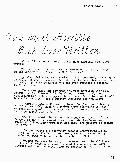
Robert Bloch
All right, students--what is the most horrible book ever written?
The Necronomicon? No, this volume doesn't exist, except in the imagination of the late H. P. Lovecraft.
Justine, Juliette, or the other titles penned by the Marquis de Sade? Strong contenders, but the events described therein are scarcely appalling to anyone who has ever attended a science fiction convention.
There are those who say that the most horrible book ever written is The Chinese Doll, by Wilson Tucker. They have a convincing argument to support their contention (the book itself) but unfortunately there's another candidate for the award.
I hereby nominate Horror! by Drake Douglas, published by MacMillan in 1966, which the jacket blurb describes as "the definitive compendium of horror" and "a dandy volume to have handy to settle arguments ..."
The same jacket identifies the author as follows; Kuala drink Douglas is the pseudonym of a gentle and < deeply involved with horror story of his life--and prefers to remain anonymous. "
His preference for anonymity becomes understandable to anyone who reads the book; he merely wants to avoid being lynched by fans of horror movies and horror fiction.
Leading the necktie party, of course, would be all those dedicated students and researchers of the macabre who have devoted years to a serious study of fantasy on film--men like J.Vernon Shea and Walter Lee, Jr. --whose hopes of eventually publishing an accurate and definitive volume on the subject must necessarily be dimmed after the appearance of this "dandy" effort. A reading will settle neither arguments nor stomachs, and the book can only be described as--well, let's put it this way; it would never have been published if we had stricter laws against abortion.
The pseudononymous gentlemen who penned it had more guts than the string section of the Philadelphia Orchestra. He sets out to describe the classic horror tale without, apparently, having read them. Or if he did, then he must have gotten hold of some very poor specimens in Braille. (I assume he's blind because he obviously hasn't seen most of the films he also describes.) Douglas manages to mix up the plots of the books with the plots of the film versions--and in doing so gets both wrong, in the case of such easily-available classics as Dracula and Frankenstein.
Let's take a mercifully-brief, shuddering look at some of the erudition displayed by this authority on the subject of horror movies. Opening the book at random one runs across such gems of information as the following:
"Intelligent and beautiful productions of classic horror" were made by the " Mike Hammer Productions of England".
How's that for openers? "Mike Hammer Productions" indeed! Even a seven-year-old reader of his first copy of Famous Monsters doesn't confuse Hammer Films with the name of Mickey Spillane's famous (or infamous) detective.
But Douglas is a true royalist, dedicated to confusion's reign.
Again, sampling at random, here are some of the "facts" he presents ...
The Wolf Man was filmed in the "early thirties" and was followed by The Werewolf of London. (The Wolf Man was released in 1941; The Werewolf of London in 1935). But this is hardly a chronological problem for a writer who captions a still of Spencer Tracy's Dr Jekyll and Mr. Hyde as a "1954" picture.
Douglas also believes that Frankenstein was made before Dracula. He tells us that "Dwight Fry" played the role of Jonathan Harker in the latter film. In The Mummy, he informs us that Boris Karloff was called "Karis" and that his inamorata was "Ananka". He also describes how Karloff, a man of "common birth" uses the "life-reviving tana leaves". (There are, of course, no tana leaves used or mentioned in this film; Karloff was a temple priest, not a commoner; his name was Imhotep and his beloved was Anksanamon. Naturally, one only finds this out if one has actually seen the picture).
The authority on horror films admits he has never seen the silent version of The Phantom of the Opera --a statement equivalent to that of an authority on Biblical history telling us he hasn't read the Book of Genesis --but at least by so doing he spares us from an additional spate of misinformation. He does manage, however, to discharge his accounts of the book and the remakes, and thus retains his stature.
He seems to think that the original The Cat And The Canary had "bayou swamps" as a locale and speaks of the "haunted-swamp atmosphere" which is a more accurate description of his imagination that of the film's setting.
His hearing is apparently inpaired, too; the famous chant in Island of Lost Souls --"Are we not men?"--comes out in his text as "We are men".
In case someone thinks I'm being just a wee bit personal in my remarks concerning Mr. Douglas, I refer you to his indulgence in personalities as he describes the attributes of Edgar Allan Poe and H. P. Lovecraft. Poe emerges as a drunken degenerate and HPL walks through a "cold wind" (he never ventured out in cold weather) with "blazing eyes" like a character in one of the "Mike Hammer" films which Douglas so enjoys.
Lovecraft, by the way, is identified as the author of such stories as Pickman's Models (sic.) and the denouement of The Whisperer In Darkness, we are told, finds the hero discovering, in a chair, the clothes, face and hands of Ackeley, along with "a mass of green slime". (sick?)
Well, kiddies, we find no "mass of green slime" in Lovecraft's story.
Hoping you are the same ...
---Robert Bloch
Data entry by Judy Bemis
Hard copy provided by Geri Sullivan
Data entry by Judy Bemis
Updated August 29, 2002. If you have a comment about these web pages please send a note to the Fanac Webmaster. Thank you.